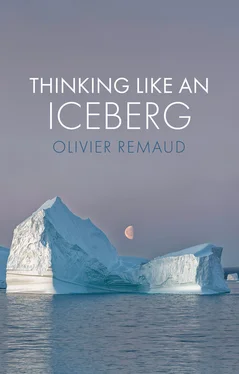An iceberg emerging from the mist has all the features of a miracle.
It is inexplicable: how can one describe it? The appearance of a mass on the water, the memory of the moment when it broke away from a glacier, its immense dimensions, the fear of a collision, all these elements ‘disturb’ one’s habits. The mind feels the need to find clearer and more stable meanings. It must be able to fill its confusion. Metaphors help it to rationalise its ‘situation of need’. 18They domesticate the feeling of ‘the uncanny’, as Sigmund Freud put it, that icebergs inspire. They tame the irrational part of the sublime feeling, when nature is frightening. Their role is to re-establish, as far as possible, an unequivocal, or at least a more reassuring, order of understanding. For this reason, the iceberg gives rise to many metaphors. It also becomes the ideal partner for inner conversations. Everyone recognises their own image in it. On the condition that we admit its finitude. But in what way exactly?
Walter Benjamin closely studied the use of allegory in Baroque drama. He interprets this figure as the language of the creature separated from its origin by the original sin. No transcendence governs its existence any more. No salvation is possible. Everything is frozen. With the allegory, history itself becomes crystallised. The ‘observer is confronted with . . . a petrified primordial landscape.’ 19In the history of art, baroque allegories do not present themselves with harmonious lines, as symbols of eternity. They show skulls. The skull is the face of time.
The polar romantic spirit extends and interprets the content of baroque allegory in its own way. An iceberg floating alone carries the spleen of the fragile human condition. In the nineteenth century, many explorers and less adventurous travellers internalised this feeling. Their metaphors reflect this. Icebergs become gigantic skulls. For the fallen conquerors, these blocks are princely figures in an archaic setting. They illustrate the vanity of mankind, like personal tombs that anticipate a collective disaster. They themselves are destined to be destroyed and are glaciers in mourning. They bear witness to the glacier’s slow death. As they calve, the fragments reveal the meaning of the whole. They express the evolution of a world on the threshold of catastrophe.
In the end, icebergs are fascinating because they embody a series of insoluble paradoxes. They give rise to hope as much as to despair. Their solid forms say, first of all, that they will last. They arouse a desire for permanence. Then they erode, showing that they are destined to fall apart. The block is ephemeral. On the one hand, it sculpts itself, changing its appearance in a short time. Its ability to reinvent itself is captivating. On the other hand, it reminds us of the fleeting nature of existence, impeding any real consolation.
The romantic spirit is sometimes euphoric, sometimes inconsolable. It combines exaltation and sadness, the passion for the grandiose and the allegorically natural. It admires monumental nature and contemplates death. It always sees icebergs as something other than what they are: contours and proportions that evoke familiar faces, animal profiles, the silhouettes of buildings, or even skulls. In the middle of the polar oceans, everyone interprets their morphological diversity through the prism of their desires or concerns. Sometimes they know that the causes of their changing aesthetics lie elsewhere: winds, currents, collisions, warm waters. Perhaps they even suspect that without ice there would be no humanity, or any other life.
But icebergs capture all the metaphors and reflect them back without absorbing them. They are the mirrors of personal histories as much as of myths of conquest. They exacerbate the constantly self-reflective sensibility of the Moderns. 20The aesthetics of the sublime is an aesthetics of humans who speak to other humans.
Mirror, my beautiful mirror
Church and Noble’s journey is over.
More than a century later, a professional sailor is sailing in the Southern Ocean. His mind is made up: he leaves the first run of the solo round-the-world race in March 1968. It didn’t matter that he had a good chance of winning. He left the competition because he wanted to follow his own path, away from ‘civilisation’ and all its fakery. Using a home-made slingshot, he fires a brief message onto the deck of an anchored oil tanker: ‘I am continuing non-stop to the Pacific Islands, because I am happy at sea, and perhaps also to save my soul.’ 21Despite his melancholy, he moves even further away from his family and friends and ventures towards Cape Horn and the Pacific, towards the Galápagos Islands.
Bernard Moitessier listens to the wind during his flight. He talks to the clouds and counts the raindrops on the sails. Dolphins accompany him for a few days and guide him off the reefs. Childhood memories come back to him. He cuts his beard every week to enjoy his own morning porridge clean-shaven and does yoga exercises in the cockpit of his small sailing boat. He travels towards peace and freedom. He lives in the present in order to ‘forget the world, its merciless rhythm of life’. 22
The sailor fears that icebergs will cut his path. His nights become more chaotic than usual. He hardly sleeps at all. When he sees flocks of Cape larks flying around in the distance, he suspects that he is about to enter an area of coastal ice. He is wrong and manages to get around the drifting blocks. He writes: ‘Seeing an iceberg in fine sunny weather. It must be the most beautiful sight a sailor could lay eyes on, a thousand ton diamond set on the sea, glittering beneath the southern sun. It might be enough to last me the rest of my life.’ 23
Unlike James Cook, Moitessier did not cross the Antarctic Circle several times in an attempt to discover the continent that scholars and ministers talked about in the gilded halls of the British capital. He is not brought to a stop before an impassable wall, peopled by giants. When he returns and publishes his story, the collective imagination does not take off like a grass fire. The world is not enthralled by the ‘islands of ice’ floating in the Southern Ocean. His ‘diamond’ sparkles are not as mystical as those in Brendan de Clonfert. The allegorical tendency of polar romanticism is foreign to him. Unlike Noble, he is not one for rhetorical emphasis. Instead, he relishes simple words that speak of the possibility of a quite profane ecstasy.
He is afraid of icebergs. But he assumes that seeing just one of them will satisfy his wanderlust. He knows that many have wanted to pass through an imaginary mirror and have bumped into their own faces, like Narcissus in the clear water of a spring. Some have perished. He just runs away.
The iceberg is the mirror that the Moderns set up between them and nature to contemplate themselves. They imagine another side in order to get closer to their reflection. Self-esteem needs a magnetic North or South, a specular material.
But, over there, the cold does not become hot, the maps of the world do not invert, the compasses do not come to life like the chess pieces in Lewis Carroll’s tale of Alice’s adventures in Wonderland.
There is no mirror there.
1 1. Elisha Kent Kane, The US Grinnell Expedition in Search of Sir John Franklin: A Personal Narrative, New York: Harper & Brothers, 1854; also his Arctic Explorations: The Second Grinnell Expedition in Search of Sir John Franklin, 1853, ’54, ’55, Philadelphia: Childs & Peterson, 1856.
2 2. Francis Leopold McClintock, The Voyage of the Fox in the Arctic Seas: A Narrative of the Discovery of the Fate of Sir J. Franklin and his Companions, London: John Murray, 1859.
3 3. Louis Legrand Noble, After Icebergs with a Painter: A Summer Voyage to Labrador and around Newfoundland, New York: D. Appleton, 1861, p. 47.
Читать дальше












